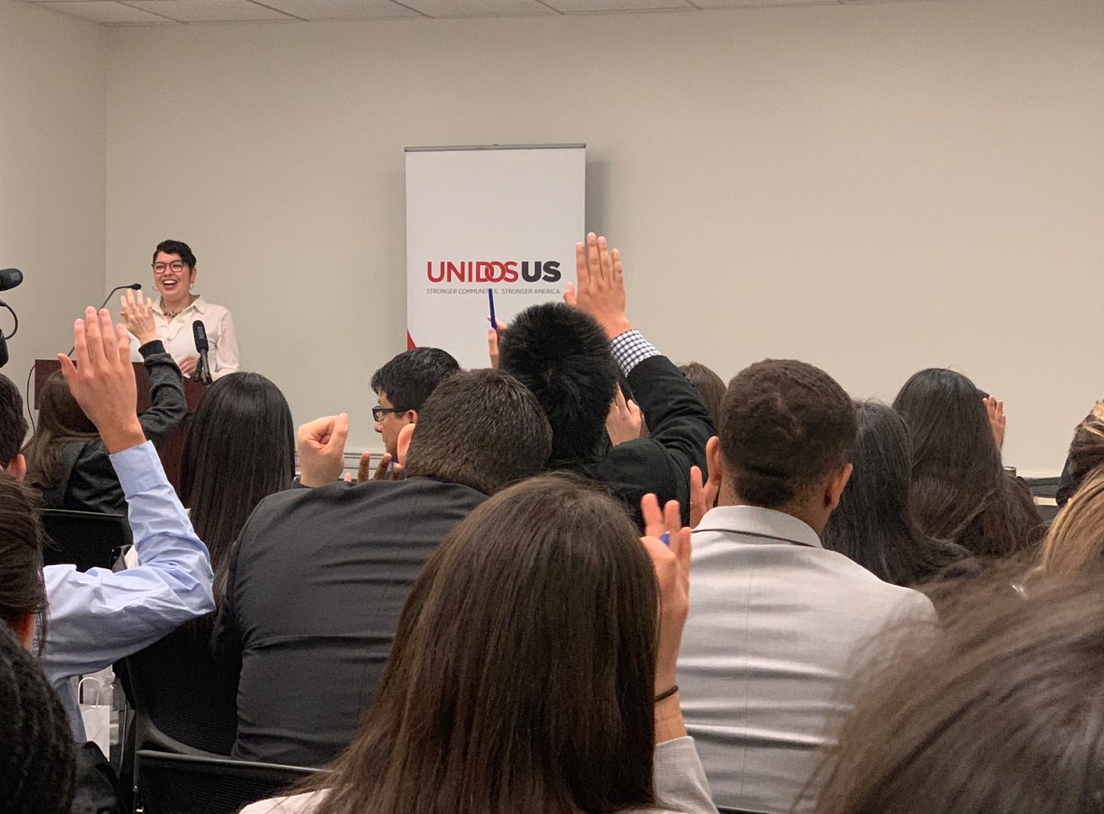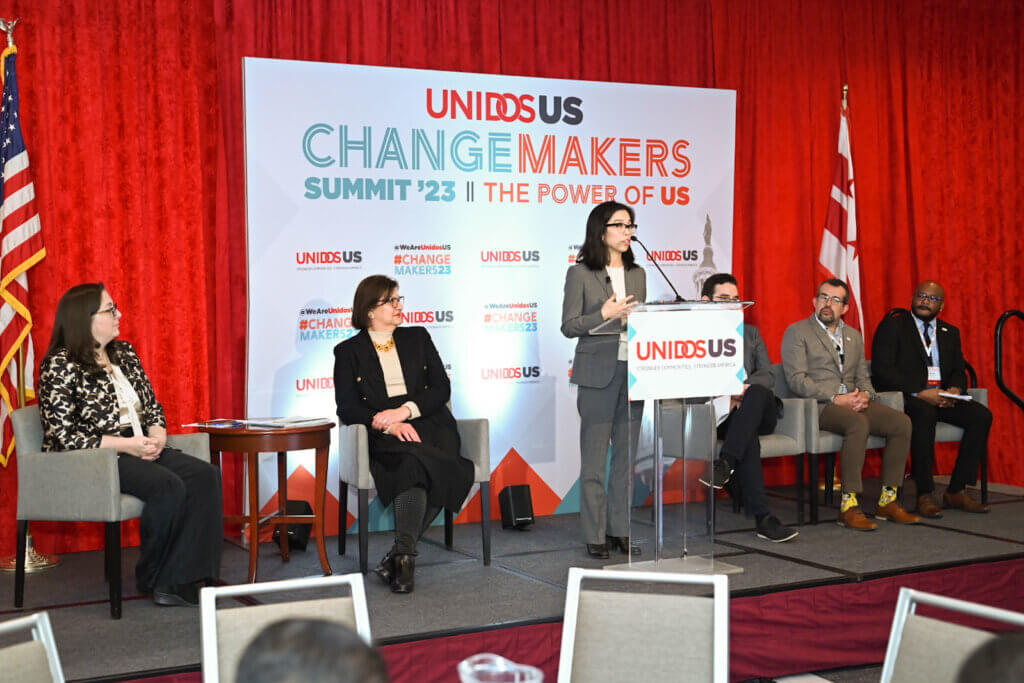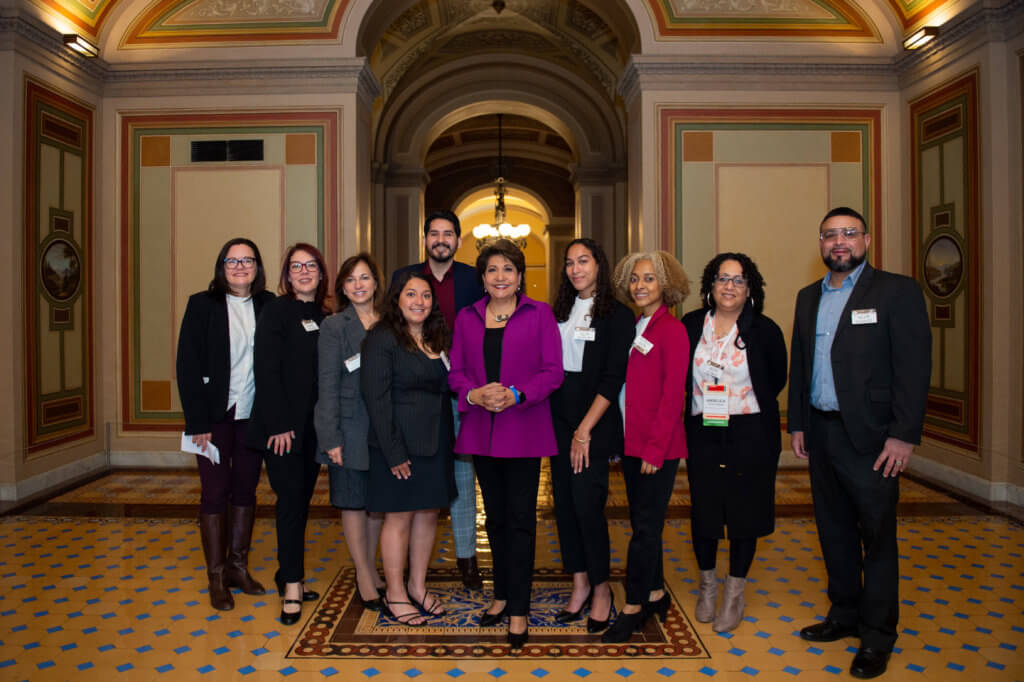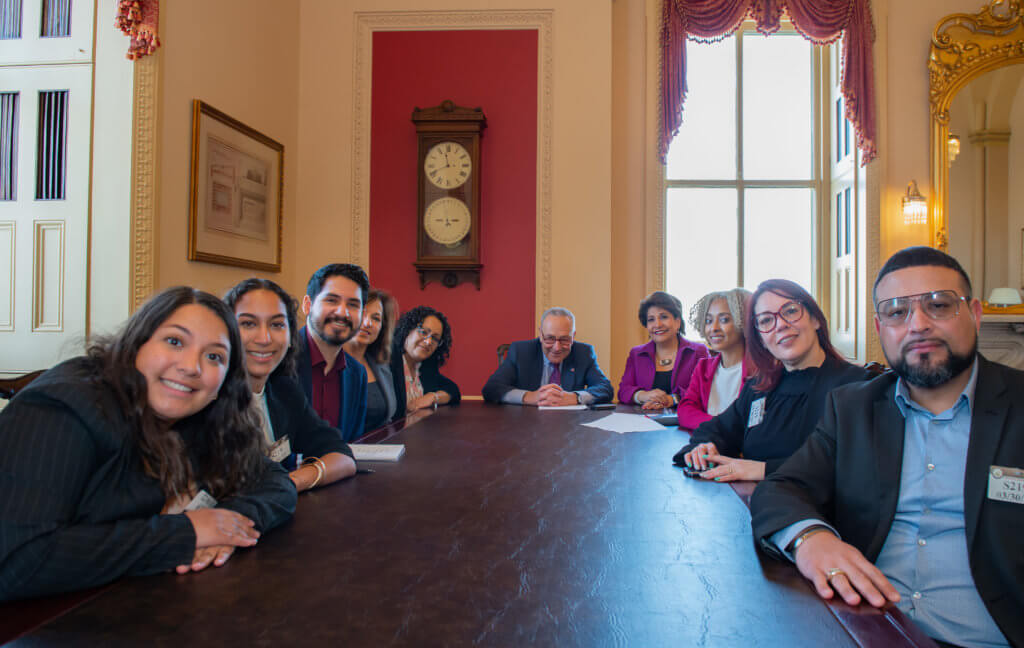If College is Essential, It Should be Affordable, Say Latino Youth, UnidosUS Staff at Capitol Hill Briefing

On a sunny, March afternoon in Washington, local high school students Amy Soto, Tiffany Flores, along with local college student Katya Quintanilla strutted past the cherry blossoms and crammed themselves into a narrow, windowless basement room in the U.S. Capitol building to serve as panelists during a policy briefing for Hill staffers about one of the most important seasons of their lives.
Soto and Flores were representing Escalera, an UnidosUS program aimed at making Latino youth more academically, logistically, and financially prepared for college. They participate in that program through UnidosUS affiliate Mary’s Center. Quintanilla came as a soon-to-be-graduating college senior from Trinity Washington University. Other youth in the group were there as part of the UnidosUS’s three-day Changemakers Summit, a program to teach Latino high school students the ropes of public policy and advocacy. And the staffers? The vast majority were just a couple of years older than these youth. All of the above came with concerns about the cost of higher education, just as Congress, after a decade, considers reauthorizing the Higher Education Act, and they wanted the staffers to hear their concerns.
This piece of legislation governs the foundation of our post-secondary system. For instance, it establishes rules for what institutions are able to access federal aid, which will be administered to students. UnidosUS’s goal was to ensure that the issues Latinos face as they encounter accessing, completing, and affording college were understood and heard by those working on Capitol Hill.
“As the daughter of Mexican immigrants and a first-generation college student, even though college was expensive, I knew that I couldn’t afford NOT to go to college if I wanted to achieve my goals and help my family financially in the future,” UnidosUS Senior Policy Analyst Stephanie Roman told the group.
It’s little wonder the presentation drew over 70 people. Latino youth represent about a quarter of the U.S. school population and they are attending college at increasingly higher rates. Between 1990 and 2016, Latino enrollment increased 337 percent. They now represent one in five students in higher education. But these students are more likely than their non-Hispanic peers to drop out before completing a full degree and to default on student loan payments.
Three new UnidosUS policy briefs presented at the event delve into the many contributing factors. For example, nearly half of these Latino students are independent or caregiver students, 40% of Latino students work more than 20 hours a week, and nearly half have an expected family contribution of $0.
Enrollment and Completion
The first brief, Enrollment and Completion, shows that high school graduation rates among Latino youth has seen very rapid growth, with 79% of Latino students earning their diplomas in 2016 compared to 71% in 2010.
And not only are they attending college at higher rates, Latino college students today— 75% of them—are more likely be the first generation in their families to do so. At the same time, they often struggle to stay in school or complete it in a traditional four-year trajectory.
The study finds that about 37% of them were more likely to attend school just part-time and nearly half (48%) had an expected family contribution of $0 to pay for tuition and other costs. This is compared to just under 30% of White students.
According to Federal Reserve Board Survey cited in the briefing, Latinos attributed their college drop-out rates to those very costs.
Financing and Student Loans
The second brief, Financing and Student Loans, notes that the cost of college tuition has risen 65% since 2000, forcing low-income students to take bigger loans.
It also notes that the Pell Grant, a federal grant given to low-income students, covers a smaller percentage of those costs. While 47% of Latino undergraduates received a Pell Grant grant, the total purchasing power covers just 30% of public institutions and 14% of private ones, compared to 76% and 35% of those costs in 1979.
To further complicate matters, students can only receive Pell Grants by filling out the Free Application for Federal Student Aid (FAFSA), using their parent’s tax IDs. The 100-plus questions on the FAFSA form are known to be confusing for all students, but especially for those who are the first in their families to go to college. In fact, many find it so dauting they worry they won’t qualify and opt out of applying for the funds. Meanwhile, undocumented students and recipients of the Deferred Action for Childhood Arrivals or DACA program are ineligible for federal financial assistance of this kind.
Student Loan Repayment
The final brief, Student Loan Repayment, notes that while Latino and White students take out about the same amount of loans, Latino students are more likely to default on paying those back. In 2004, for example, one in five first-time Latino college students defaulted on their student loans within 12 years, which is nearly twice the rate of their White peers. Latino college students who began their degrees in the 2003-2004 schoolyear still owed 83% of that original balance after 12 years, compared to White borrowers who owed 65%.
One of the major contributing factors is salary rates upon graduation. Data from the U.S. Department of Education show that college-educated Latinos aged 25-34 earn about 10% less than their White peers. Their annual median incomes were $49,300 compared to $54,700 for Whites.
Student Stories
Much of the data presented in these briefings resonated with the three student panelists who spoke at the event. As participants of UnidosUS’s Escalera: Taking Steps to Success Program, students receive guidance and mentorship they might not get at home from parents who didn’t go to college or at their often-short staffed high schools where guidance counselors are few and far between. The Escalera program, founded in 2001 is a cohort-based program that supports students navigate the college-going process with a culturally competent lens that elevates their voice, talents, and aspirations. Through Escalera, students develop several competencies including educational attainment, college readiness, career exploration, and leadership. The Escalera program is delivered through curricular-based sessions, experiential learning activities including internships, and case management which allows each student individualized advising time.
Katya Quintanilla, now a senior at Trinity Washington University and Escalera youth leader, says her mother passed away while she was in high school, making her father the family’s sole caretaker and breadwinner. As a result he didn’t have much time to advise Quintanilla on applying for college, much less paying for it.
“For him it was more like you figure it out, do what you need to do,” she said.
By working with Escalera and the local Latino outreach organization Mary’s Center, Quintanilla was able to identify Trinity University as a private institution that works to meet the needs of students like her. She managed to avoid college loans for all but her last year of college. By doing so, she will be able to start contributing more to the family’s household income when she graduates and begins her career.
Meanwhile Amy Soto, a student at Columbia Heights Educational Campus in Washington, DC, said her parents are the impetus to push forward toward that high degree.
“They’re my inspiration to get my education because they’re low income,” she said, noting that they didn’t have much money to help her get there but they have served as an emotional support.
But it’s not just parents these students have to worry about. Many of them come from large families with children who are close in age. That’s affecting how Tiffany Flores, a senior at Washington DC’s School Without Walls High School, will begin her higher degree this fall. Her sister is a college sophomore who has already had to take out loans, and in another three years, Flores’s little brother may also want to go to college.
“We’re good now, but for me, I took that as more pressure on me to make sure that at the college I’m going to, I don’t have to pay so much that my parents will be struggling financially,” she said.
Juliana Ospina Cano, UnidosUS’s Associate Director of STEM and College Readiness programs, reaffirmed that these competing priorities can take a socioemotional toll on Latino students, especially those who are first generation. It’s even harder to navigate the college-going process “if we think in the context of mixed-status families or students that have a precarious immigration status” given the exclusionary policies that prevent these youth from accessing financial aid and even admission to a higher education institution, she noted. Escalera provides a supportive space that takes into account the realities of Latino youth in contemporary America.
UnidosUS’s Vice President of Policy and Advocacy Eric Rodriguez reaffirmed that the reauthorization of the higher education bill represents “a critical opportunity to ensure that equity is at the center of higher education discussions, policy proposals, and resulting legislation,” and added, “addressing the myriad barriers that Latino students face in higher education access, affordability, completion, and loan repayment is essential to upholding the promise of higher education as a path to the American dream.”




